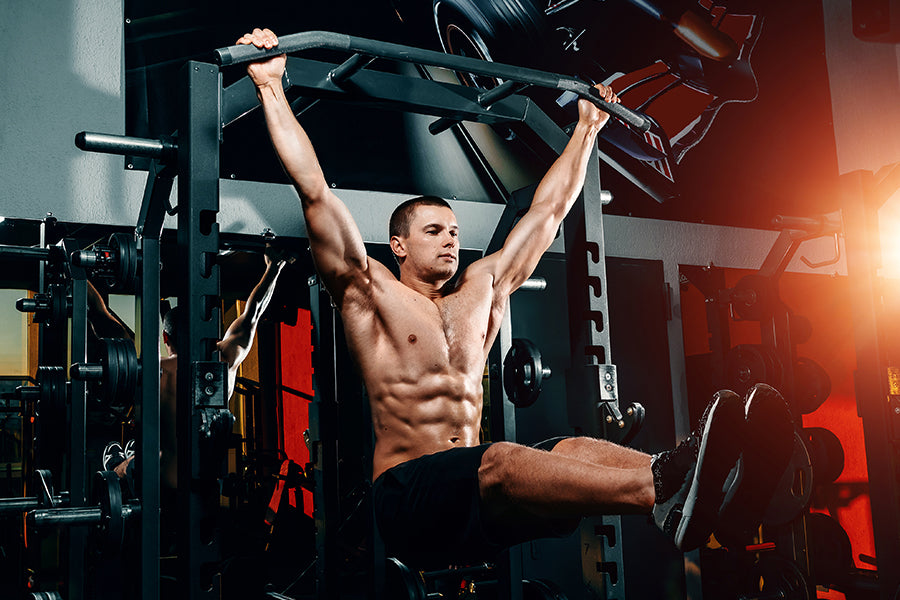Hanging leg raises are one of the best ab exercises you can do. They are a great way to work your core muscles. These are compound exercises, meaning they work more than one muscle group; this makes them incredibly effective for your abs.
This exercise helps develop strong and well-developed oblique abdominal muscles, which are key in creating a nice-looking waistline. Hanging leg raises can be done with or without weights, and they're a great exercise for beginners and advanced fitness enthusiasts.
You may have seen men or women doing hanging leg raises in the gym and thought about how to do it. This article discusses how to perform hanging leg raises with proper form and the variations and mistakes to avoid.
Which Muscles Do Hanging Leg Raises Work?
Hanging leg raises is a compound exercise and a great workout for your whole body, but the main muscle group worked by hanging leg raises is the rectus abdominis, more commonly known as the six-pack muscle. This muscle runs down the front of your stomach and flexes the spine.
In addition to toning your stomach, hanging leg raises also work your hip flexors and oblique abdominal muscles, which are responsible for the side-to-side bending of the midsection, and help you twist and turn your body.
Not only do hanging leg raises help develop the core, but they also work the shoulders and upper back muscles, providing an all-over body workout. As such, they are an important part of any well-rounded fitness routine and help you build strength and define your abs.
Related Article: Back Workouts for Women: 8 Best Back Exercises to Build Muscle
How to Perform Hanging Leg Raises With a Proper Form

If you're a beginner, start by doing the exercise without weights. Once you've mastered the basic form, you can add weight using a weighted vest, ankle weights, or even a dumbbell between your feet.
To do the exercise, grip the chin-up bar or other sturdy object with your hands shoulder-width apart and raise your legs until they're parallel with the ground. Hold for a second, then lower them back to the starting position. If you can't lift your legs that high, don't worry — just go as high as you can. As you get stronger, you'll eventually be able to increase your range of motion.
Keep your back straight, and your core engaged throughout the exercise. Don't let your hips swing or your upper body sway. Also, don't jerk or bounce your legs up and down — this can cause injuries.
Benefits of Hanging Leg Raises
There are many benefits of incorporating hanging leg raises into your workout routine. They include, but are not limited to:
Stronger Core
One of the primary benefits of hanging leg raises is that they help strengthen the core muscles. The core muscles are the abdomen and lower back muscles, which play an important role in stabilizing the spine. A strong core can help prevent injuries, improve posture, and increase athletic performance.
Improved Flexibility
Hanging leg raises also improve flexibility in the hips and thighs. Tightness in these muscles can lead to pain in the lower back and knees. By stretching and lengthening these muscles, hanging leg raises can help alleviate pain and improve the range of motion.
Greater Range of Motion
Another benefit of hanging leg raises is that they can help increase the range of motion in the hips and knees, reducing pain and stiffness. Additionally, a greater range of motion can improve athletic performance and reduce the risk of injuries.
Improved Digestion
Hanging leg raises can also help improve digestion by stimulating the digestive system. When performed correctly, hanging leg raises massage the abdominal organs, which can help move food through the digestive system more efficiently.
Related Article: 8 Balance Improving Exercises That Build Stability, Strength & Flexibility
Some Tips to Modify Your Workout
If you find the standard hanging leg raise too difficult, here are a few modifications you can make to make the exercise easier:
Number of Reps
If you find it difficult to do the recommended reps, start with fewer reps and work your way up. It will help you build strength and endurance gradually.
Slow Down the Movement
Slow down the movement if you find it difficult to keep your legs straight and still throughout the exercise. It will make it easier to maintain proper form.
Use a Resistance Band
Use a resistance band to assist if you find it difficult to raise your legs high enough. It will help you lift your legs and get the most out of the exercise.
Use a Lifting Strap
Use lifting straps to maximize your grip. It will take some weight off your shoulders and help keep your form in check.
Bend Your Knees
It will make the exercise a bit easier on your shoulders and help you keep good form throughout the movement.
Use Momentum
Use a little momentum to get your legs up to the starting position, this could be done in a kipping motion. This will offload your hip flexors compared to the isolated method. Try these modifications next time you do hanging leg raises, and see how they work!
Variations of Hanging Leg Raises
There are many ways to do hanging leg raises, so you can mix up your routine and target different muscle groups. Here are some of the most popular variations:
Russian Chair Leg Raises

Start by supporting yourself on a Russian chair. Keep your legs straight and slowly raise them until they are parallel to the ground. Then lower them back down to the starting position.
Hanging Knee Raises

Start hanging from a bar with your hands shoulder-width apart. Bring your legs up, then tuck your knees towards your chest. Hold this position for a few seconds, then slowly lower your legs back down to the starting position.
Repeat this action for as many reps as you can. This variation works your obliques more effectively.
Toe to Bar

This variation is the same as the hanging leg raise, but instead of stopping at 90 degrees you are bringing your feet all the way to touch the bar overhead. This targets a greater range of motion and requires much more strength. This is a movement for advanced lifters.
Hanging Side Knee Raise

Start hanging from a bar with your hands shoulder-width apart. Raise both knees up and to the side of your body. Repeat with the other side. This variation works your obliques more effectively.
Lying Leg Raise

The most basic and regressed version of a hanging leg raise is a lying leg raise. Sometime you may not possess the strength to hang and complete the movement. A great alternative to work up to this is a lying leg raise. Lie on the ground, push your back into the ground and raise your legs towards your midline. Slowly lower your legs back down while keeping your back flat with the ground.
Give these different variations of hanging leg raises a try to see which ones work best for you!
Common Mistakes When Performing and Isolated Hanging Legs Raises
Isolated hanging leg raises are often done wrong. Here are some common mistakes people make when doing this exercise:
- Not Going High Enough — Your legs should be parallel to the ground when you raise them. You're not getting the full benefit of the exercise if they're not.
- Swinging Your Legs — It takes the focus off your abs and puts it on your hips and lower back. Make sure to keep your legs straight and still throughout the entire exercise.
- Not Going Slow Enough — Quality, not quantity, is key to any good workout. If you go too fast, you risk sacrificing your form for speed. Slow down and focus on each rep to get the most out of this exercise.
By avoiding these common mistakes, you can ensure you're getting the most out of your isolated hanging leg raises and achieving optimal results.
FAQs
1. What is hanging leg raises good for?
The primary benefit of hanging leg raises is that they help strengthen the core muscles. The core muscles are the abdomen and lower back muscles, which play an important role in stabilizing the spine. A strong core can help prevent injuries, improve posture, and increase athletic performance.
2. Why are hanging leg raises so hard?
Hanging leg raises are hard because they require a lot of strength and endurance in the core muscles. The core muscles are responsible for stabilizing the spine, so they must be strong to perform this exercise correctly.
Also, hanging leg raises are challenging because they require you to lift your legs high and maintain proper form throughout the movement. If you find doing the standard version of this exercise difficult, try one of the modifications listed above.
3. Is hanging leg raise enough for abs?
There is no one-size-fits-all answer to this question, as the best way to get abs depends on your fitness level and goals. However, hanging leg raises are a challenging exercise that helps strengthen the core muscles. A strong core is essential for developing ripped abs.
4. Are hanging leg raises better than sit-ups?
That depends on what you're trying to achieve. Both are a great exercise for targeting the abs. It honestly depends on your training age. If you are a beginner you may want to start with sit-ups before you build yourself up to hanging leg raises. But to answer the question, no, one is not better than the other.
The Bottom Line
Hopefully, this article has helped you understand the benefits of hanging leg raises and how to perform them correctly. Now that you know different variations of the hanging leg raises, you can experiment with varied hand positions, adding weight resistance and/or increasing time while suspended. Lastly, we investigated the common mistakes so that you can avoid them to achieve greater gains from your workout.
Reading List
Article Sources
- Ingraham, Stacy J. “The Role of Flexibility in Injury Prevention and Athletic Performance: Have We Stretched the Truth?” Minnesota Medicine, vol. 86, no. 5, May 2003, pp. 58–61.
- Sinclair, Marybetts. “The Use of Abdominal Massage to Treat Chronic Constipation.” Journal of Bodywork and Movement Therapies, vol. 15, no. 4, Oct. 2011, pp. 436–45. ScienceDirect, https://doi.org/10.1016/j.jbmt.2010.07.007.











